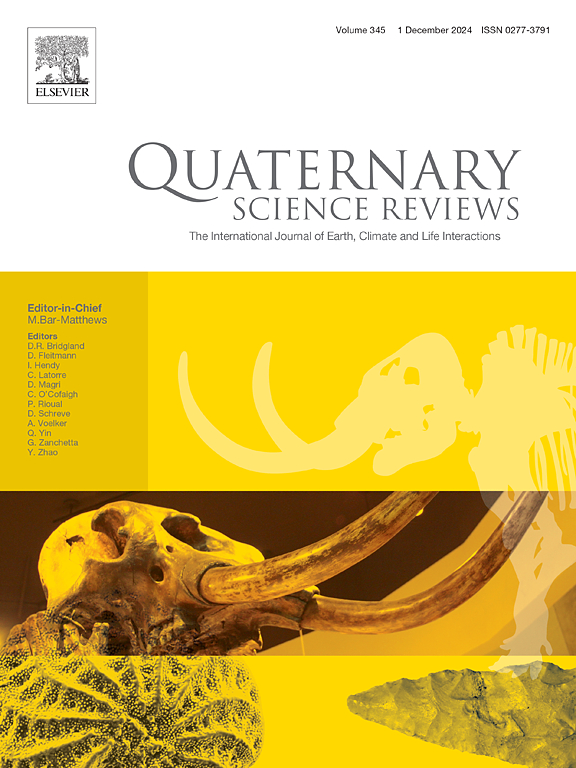Evaluating adaptability of early cereal consumption during Holocene climate fluctuation: Integrated insights from macro-botanical remains, fossil pollen records and species distribution modeling in northern China
IF 3.3
1区 地球科学
Q1 GEOGRAPHY, PHYSICAL
引用次数: 0
Abstract
Agricultural production began with the selective adaptation of wild crops. While extensive archaeological evidence indicates that northern China was one of the earliest regions to develop systematic cereal cultivation, the dynamics of early subsistence adaptation remain insufficiently understood, primarily due to limited knowledge regarding the distribution, abundance, and variation of cereals. This study integrates multiple lines of evidence, including macro-botanical data recovered from archaeological sites, pollen taxa analysis from high-resolution sediment samples, and species distribution modeling (SDM), to evaluate the interaction between wild cereal resources and human choices during Holocene climate fluctuations. The findings suggest that climatic amelioration following the Last Glacial Maximum (LGM) may facilitate the availability of wild broomcorn millet and rice in northern China. Their high abundance during the early Holocene may make these cereals dominant choices. In contrast, the climatic impact on wild foxtail millet was minimal, and its relatively lower availability likely constrained its early consumption. During the early Holocene, the composition of local vegetation may have influenced the proportion of cereals in daily diets. By the mid-Holocene, although climatic fluctuations diminished the availability of wild broomcorn millet and rice, the expansion of agriculture became the primary driver for the widespread dominance of foxtail millet. The assessment of early human adaptation reveals that the selective utilization of cereals was part of a complex ecological and economic dynamic, initially driven by disparities in plant resource availability resulting from Holocene climatic variations. Over time, however, population demands and agricultural development increasingly shaped this process.
全新世气候波动中早期谷物消费的适应性评价:来自中国北方大植物遗迹、化石花粉记录和物种分布模拟的综合见解
农业生产始于对野生作物的选择性适应。虽然大量的考古证据表明,中国北方是最早发展出系统的谷物种植的地区之一,但由于对谷物的分布、丰度和变化的认识有限,对早期生存适应的动态仍然知之甚少。本研究整合了多种证据,包括考古遗址的宏观植物数据、高分辨率沉积物样本的花粉分类群分析和物种分布模型(SDM),以评估全新世气候波动期间野生谷物资源与人类选择之间的相互作用。研究结果表明,末次盛冰期(LGM)后的气候改善可能促进了中国北方野生高粱、谷子和水稻的可利用性。它们在全新世早期的高丰度可能使这些谷物成为主要选择。相比之下,气候对野生谷子的影响很小,其相对较低的可得性可能限制了其早期消费。在全新世早期,当地植被的组成可能影响了谷物在日常饮食中的比例。到全新世中期,尽管气候波动减少了野生黍和水稻的可用性,但农业的扩张成为谷子广泛占据主导地位的主要驱动力。对早期人类适应的评估表明,谷物的选择性利用是一个复杂的生态和经济动态的一部分,最初是由全新世气候变化导致的植物资源可用性差异驱动的。然而,随着时间的推移,人口需求和农业发展日益影响着这一进程。
本文章由计算机程序翻译,如有差异,请以英文原文为准。
求助全文
约1分钟内获得全文
求助全文
来源期刊

Quaternary Science Reviews
地学-地球科学综合
CiteScore
7.50
自引率
15.00%
发文量
388
审稿时长
3 months
期刊介绍:
Quaternary Science Reviews caters for all aspects of Quaternary science, and includes, for example, geology, geomorphology, geography, archaeology, soil science, palaeobotany, palaeontology, palaeoclimatology and the full range of applicable dating methods. The dividing line between what constitutes the review paper and one which contains new original data is not easy to establish, so QSR also publishes papers with new data especially if these perform a review function. All the Quaternary sciences are changing rapidly and subject to re-evaluation as the pace of discovery quickens; thus the diverse but comprehensive role of Quaternary Science Reviews keeps readers abreast of the wider issues relating to new developments in the field.
 求助内容:
求助内容: 应助结果提醒方式:
应助结果提醒方式:


